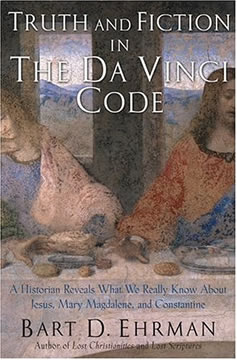Professor Bart D. Ehrman is an authority on the early Church and the life of Jesus.
He knows, and shares with his readers, how to separate fact from fiction,
and how to evaluate historical records.
He not only shows you what is true, but how anyone that takes care will be able to
assess themselves what is true.
In this way you see how the flights of literary fancy so necessary to Dan Brown
are not historical realities.
|
What Dan Brown claims in The Da Vinci Code
|
Historical fact reported by historian Professor Bart D. Ehrman in
Truth and Fiction in the Da Vinci Code
|
|
The Dead Sea Scrolls were a collection of Christian documents.
|
The Dead Sea Scrolls were not Christian documents.
They did not mention Jesus.
They were Jewish.
|
|
The Nag Hamadi documents were scrolls.
|
The Nag Hamadi documents were not scrolls.
They were books of papyrus written on both sides not one (as for a scroll)
and sewn together.
|
|
The Dead Sea Scrolls portrayed Jesus as more human than in the canonical
New Testament.
|
The Dead Sea Scrolls did not portray Jesus at all.
|
|
The Nag Hamadi documents portrayed Jesus as more human than in the canonical
New Testament.
|
It is the reverse:
the canonical New Testament tends to portray Jesus as more human than in the Nag Hamadi documents.
|
|
Jesus was married to Mary Magdalene.
| Jesus was not married to Mary Magdalene.
No known Christian records (including
the Nag Hamadi documents) report that Jesus was married to Mary Magdalene.
Mary is never identified as the wife of Jesus to differentiate her from Mary his mother and Mary of Bethany.
Instead she is identified by the village that she came from
(in the 'Magdelene' part of her name).
|
|
Mary Magdalene had a child fathered by Jesus and born after Jesus was crucified
|
Mary Magdalene did not have a child fathered by Jesus.
No known Christian records (including
the Nag Hamadi documents) report that Mary Magdalene had a child.
|
|
Mary Magdalene is the real "Holy Grail" by holding the seed of Jesus.
| Again, there is no evidence.
|
|
There is a line of descent from Jesus and Mary Magdalene, beginning with the birth of their daughter,
that has continued for two millennia and exists today.
| Again, there is no evidence.
|
|
Jesus kept a record of his teaching.
|
There is not record that this happened.
And it was quite rare that people kept such a record.
|
|
People made records of Jesus' teaching while he was alive.
|
There is not record that this happened.
Only 10-15% of the population was literate and very few of those were fishermen, artisans, and farmers.
Most of the people that accompanied Jesus would be illiterate.
|
|
The elusive
'Q' document
was written by Jesus.
|
It was not.
This is a hypothetical document that was written (if at all)
two decades after Jesus' death.
|
|
Accounts of Jesus were written at the time he was alive.
|
There are no accounts
from a disciple, a Roman citizen, or an imperial authority written at the
time Jesus was alive.
In particular there is no record by the authorities of his trial.
The first known writings about Jesus by Christians appeared about 65-70 C.E. in the
Gospel according to Mark, three decades after the death of Jesus.
The first known writing about Jesus by non-Christians was in 112 C.E.
(about eight decades after the death of Jesus).
|
|
Emperor Constantine select for the New Testament (from 80 contending gospels)
only the four gospels that stressed that Jesus was divine?
|
(1) There were not 80 but far fewer gospels contending for inclusion in the canonical New Testament.
(2) The definition of the canon began before the time of the Emperor Constantine
and continued through his time.
(3) The selected four gospels stressed that Jesus was more human
(not less human) than do most of the contending gospels.
|
These are merely the iceberg's tip.
For the joy of learning the best that we know about early Christian truth, see:
The novel is a detective/thriller/conspiracy-theory fiction,
claiming that the Catholic Church has a conspiracy to hide the "true" story of Jesus.
While people like the historian Bart D. Ehrman
have found is an enthralling "page turner".
In fact, Ehrman says he has recommended it to others.
I, on the contrary, have not. The book is poorly written.
The sloppiness of the plotting and the uninteresting writing make
me suspect that the following claim made by Brown is also sloppy:
 Biopsychology.
Biopsychology.
 Death and Dying.
Death and Dying.
 Ecology.
Ecology.
 Enneagram.
Enneagram.
 Evolution.
Evolution.
 Evolutionary Psychology.
Evolutionary Psychology.
 Personality Psychology
Personality Psychology
 Psychological research methods.
Psychological research methods.
 Nature of Prejudice by Gordon W. Allport.
Nature of Prejudice by Gordon W. Allport.
 Learned Optimism by Martin E. P. Seligman.
Learned Optimism by Martin E. P. Seligman.
 Pessimism (defensive) (Norem).
Pessimism (defensive) (Norem).
 Our BLOG (web log) of Books to read.
Our BLOG (web log) of Books to read.
 Book Log archive.
Book Log archive.
 Best books read.
Best books read.
 Reviews of Harry Potter books.
Reviews of Harry Potter books.
 New books on Christianity and Spirituality by Pagels, Ehrman, et al.
New books on Christianity and Spirituality by Pagels, Ehrman, et al.

